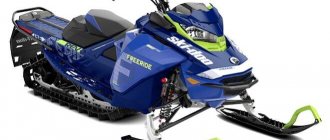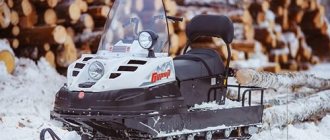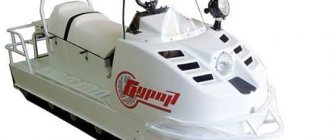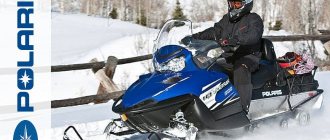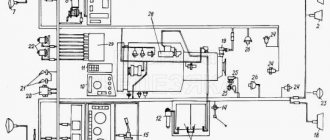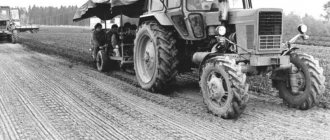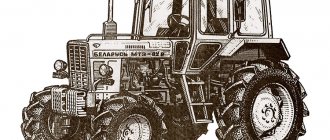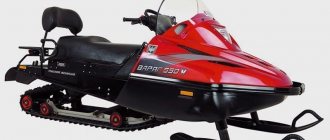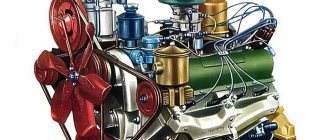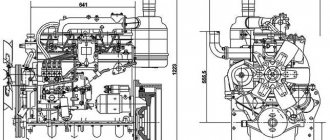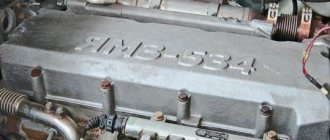"Buran A/E" - detailed review
The snowmobile is equipped with a dynamic engine with a power of 34 hp. The working volume of 635 cc is enough to move through the snowdrifts as quickly as possible. All components and assemblies of this model are made to last, as evidenced by numerous positive reviews from Buran owners. That is, we can safely say that riding a domestic snowmobile fully meets safety requirements. Driving the snow machine is very easy. The steering wheel quickly responds to the driver's movements, which are transmitted to the front track. It is worth noting the high maneuverability of the unit. Movement in a dense forest area does not present any difficulties for Buran. To make it easier for the driver to select the required driving mode, the developers install a two-speed gearbox on the latest models.
Appearance and tuning of the snowmobile
This snowbike got its name in honor of a snowstorm, which is why its hood is invariably white. The vehicle is in great demand due to its relatively low cost, cross-country ability and traction properties. The price of a new snowmobile version 4T from an official dealer is 355 thousand rubles. A model with a long platform will cost 20 thousand more.
On the Internet you can find a lot of positive feedback from owners, look at reviews and test drives. In addition, Buran lends itself well to modernization. Of course, it won’t be possible to turn a budget utility vehicle into a racing truck, but it is quite possible to improve its performance characteristics.
To reduce noise levels, sealed bearings are installed. The Safari regulator, which is installed from the factory on snowmobiles of the Taiga line, helps to increase the number of engine revolutions. If you install an on-board computer, the all-terrain vehicle will look no worse than its expensive foreign counterparts.
Full tuning
There are a number of companies that offer assembled kits for the complete modernization of this all-terrain vehicle. However, each owner can assemble such a set himself and save money. Standard kit includes:
- Honda engine (22 hp, 2 cylinders);
- Arctic regulator with four positions;
- Battery with a capacity of 24 ampere-hours;
- fastening cable for the power unit;
- soundproofed hood;
- bumper bumper.
In addition, you can install a lightweight spring on the brake mechanism. This will make the stopping process more comfortable.
Repairs and breakdowns
Main malfunctions and ways to eliminate them:
- If the engine does not start, it is necessary to disconnect the ends of the fuel pipe and bleed the system, wash all filter elements, clean the vent hole, and replace gasoline.
- If there is no spark at the spark plug electrodes, you should check the mechanism for damage and defects, clean the spark plugs from carbon deposits, and adjust the gap.
- If the gearbox chain breaks, it is recommended to replace the chain mechanism; to do this, you will need to remove the track.
- If the gearbox turns off while driving, the entire mechanism should be disassembled, the spring and other worn parts should be replaced.
- If oil fluid leaks from the gearbox, it is necessary to adjust the cuffs and replace damaged and worn parts.
- If the snowmobile does not develop full power, it is recommended that the track belt tension and alignment be adjusted.
- If leakage occurs through the shaft seals, they must be replaced.
What affects fuel consumption and how to reduce it
- Fuel consumption is affected by the condition of the engine and its displacement, operating conditions, the number of working electrical appliances (radio tape recorder, headlights, electric drives, etc.), the quality of the fuel and oil poured.
- To improve engine efficiency, it is not recommended to warm up the engine for too long. It has long been proven that warming up the engine while driving is more effective than warming it up before driving.
- Gentle driving at low engine speeds allows you to reduce consumption
- To increase the efficiency of the internal combustion engine, you must try to load the generator as little as possible. To do this, you will have to turn on various electrical equipment as little as possible.
- The use of high-quality fuel and oil contributes to reliable and economical operation of the engine, which must be selected according to factory specifications and requirements.
Video
The family of snowmobiles in question was originally created as a working vehicle for military needs, as well as operations with cargo and long trips in the taiga and at low temperatures. The developers set themselves the goal of making a balanced vehicle capable of towing loads. The machine copes with this task flawlessly even if it is subjected to the transportation of goods on a daily basis. Of course, this speaks of excellent durability and the use of quality materials. The developers endowed the power part of the snowmobile with a large traction force, which was achieved due to the large gear ratio of the gearbox. So, especially for this purpose, the snowmobile is equipped with a continuously variable transmission, which ensures the full potential of the power plant. This can be explained by the fact that this gearbox is adapted to the maximum torque that the power plant develops. Accurate and calibrated tuning of the internal combustion engine and gearbox has led to the snowmobile being able to transport loads weighing 250 kg or even more.
Let us note once again that we are considering two models - Buran A and Buran AE. The latest, improved model has an improved design, which can be appreciated by the original design of the hood
By the way, the hood lid has a modified fastening scheme, thanks to which, when opening the lid, full access to all working parts and components of the internal combustion engine is provided. The hood material is high-strength injection molded plastic. This lightweight material not only had a beneficial effect on reducing the weight of the snowmobile. Moreover, such a hood does not crack and withstands low temperatures perfectly. In addition, we note an increased level of comfort thanks to the two-seater layout with a passenger backrest.
The machine is simple and unpretentious in long-term operation and maintenance, in terms of the cost of components and maintainability. A highly developed dealer network, spread across all cities and regions of Russia, confirms the Russian origin of the Buran A and Buran AE family of snowmobiles.
Video
Lengthening the snowmobile structure had a positive effect not only on cross-country ability, but also on comfort. The extended frame made it possible to install a double, two-level seat on the snowmobile, and besides, the snowmobile became a little easier to control on various surfaces. But the machine also has its drawbacks, one of which is insufficient maneuverability, as a result of which the snowmobile is not suitable for use in forest areas, since maneuvering between trees is very difficult. The main purpose of the Buran AD/ADE snowmobile is also to tow various loads and use it as a compact tractor, which the machine does just fine. According to the manufacturer, the snowmobile is capable of dragging a load weighing no more than 500 kilograms, but many owners have transported more. The tracks were also lengthened, which, in addition to cross-country ability, also gave improvements in chain properties, which is what makes the machine a multi-purpose workhorse, and also allows you to move on slopes and sloping surfaces with loose snow much more confidently than previous models.
The design of the new Burans largely copies early models, since extensive experience and time of operation have shown that this design is very simple and has impressive maneuverability and traction properties. Burans also boast of their high reliability and maintainability. The car can be repaired even in rather extreme conditions far from civilization, which also influenced the popularity of this technique.
Important TOP 3 best McCulloch chainsaws for household use
The snowmobile is often used by professional hunters and fishermen, as well as those who work in harsh conditions, again due to the reliability of the machine and the availability (both in terms of search and cost) of the necessary spare parts. In addition to performing household tasks, Buran AD/ADE is an almost indispensable assistant in organizing sports and public events of the highest level. For such purposes, the snowmobile is equipped with special additional equipment, with which it lays various types of ski slopes. It is worth noting that with such equipment the machine is especially effective both for preparing classic ski slopes and for skating tracks, regardless of the size of the snow cover.
Excerpt characterizing Buran (snowmobile)
Everyone was silent, one wanderer spoke in a measured voice, drawing in air. “My father, the people came and said to me: great grace has been revealed, myrrh is dripping from the cheek of the Mother of the Most Holy Theotokos...” “Okay, okay, you’ll tell me later,” said Princess Marya, blushing. “Let me ask her,” said Pierre. -Have you seen it yourself? - he asked. - Why, father, you yourself have been honored. There is such a radiance on her face, like heavenly light, and mother’s cheek keeps dripping and dripping... “But this is a deception,” said Pierre naively, who listened attentively to the wanderer. - Oh, father, what are you saying! - Pelageyushka said with horror, turning to Princess Marya for protection. “They are deceiving the people,” he repeated. - Lord Jesus Christ! – the wanderer said, crossing herself. - Oh, don't tell me, father. So one anaral did not believe it, he said: “the monks are deceiving,” and as he said, he became blind. And he dreamed that Mother of Pechersk came to him and said: “Trust me, I will heal you.” So he began to ask: take me and take me to her. I’m telling you the real truth, I saw it myself. They brought him blind straight to her, he came up, fell, and said: “Heal! “I will give you,” he says, “what the king gave you.” I saw it myself, father, the star was embedded in it. Well, I have received my sight! It's a sin to say that. “God will punish,” she instructively addressed Pierre. - How did the star end up in the image? asked Pierre. - Did you make your mother a general? - said Prince Andrei, smiling. Pelagia suddenly turned pale and clasped her hands. - Father, father, it’s a sin for you, you have a son! - she spoke, suddenly turning from pallor to bright color. - Father, what did you say? God forgive you. - She crossed herself. - Lord, forgive him. Mother, what is this?...” she turned to Princess Marya. She stood up and, almost crying, began to pack her purse. She was obviously both scared and ashamed that she had enjoyed benefits in a house where they could say this, and it was a pity that she now had to be deprived of the benefits of this house. - Well, what kind of hunting are you doing? - said Princess Marya. “Why did you come to me?...” “No, I’m joking, Pelageyushka,” said Pierre. - Princesse, ma parole, je n'ai pas voulu l'offenser, [Princess, I'm right, I didn't want to offend her,] I just did that. Don’t think I was joking,” he said, smiling timidly and wanting to make amends. - After all, it’s me, and he was only joking. Pelageyushka stopped incredulously, but there was such sincerity of repentance in Pierre’s face, and Prince Andrei looked so meekly first at Pelageyushka, then at Pierre, that she gradually calmed down. The wanderer calmed down and, brought back into conversation, talked for a long time about Father Amphilochius, who was such a saint of life that his hand smelled like palm, and about how the monks she knew on her last journey to Kiev gave her the keys to the caves, and how she, taking crackers with her, spent two days in the caves with the saints. “I’ll pray to one, read, go to another. I’ll take a pine tree, I’ll go and take a kiss again; and such silence, mother, such grace that you don’t even want to go out into the light of God.” Pierre listened to her carefully and seriously. Prince Andrei left the room. And after him, leaving God’s people to finish their tea, Princess Marya led Pierre into the living room. “You are very kind,” she told him. - Oh, I really didn’t think of offending her, I understand and highly value these feelings! Princess Marya silently looked at him and smiled tenderly. “After all, I have known you for a long time and love you like a brother,” she said. – How did you find Andrey? - she asked hastily, not giving him time to say anything in response to her kind words. - He worries me very much. His health is better in winter, but last spring the wound opened, and the doctor said that he should go for treatment. And morally I am very afraid for him. He is not the type of character we women are to suffer and cry out our grief. He carries it inside himself. Today he is cheerful and lively; but it was your arrival that had such an effect on him: he is rarely like this. If only you could persuade him to go abroad! He needs activity, and this smooth, quiet life is ruining him. Others don't notice, but I see.
Specifications
- Length (short version) – 2700 mm
- Length (extended version) – 3100 mm
- Body width/windshield height – 910/1335 mm
- Drawer dimensions: Length/Width/Height, mm: 2420/1060/1130
- Front suspension - elliptic spring
- Rear suspension – independent, with springs
- Front/rear suspension travel – 50/50 mm
- Front springs, pcs. - 1
- Propulsion - caterpillar, with front drive sprockets
- Caterpillars, pcs. – 2
- Tension mechanism – screw
- Caterpillar belt - rubber-fabric, with plastic rods
- Track length (short version) – 2878 mm
- Track length (extended version) – 3685 mm
- Track width – 380 mm
- The height of the lugs is 17.5 mm
- Installed transmission – variator, with gears “forward”, “down”, “reverse”, “neutral”
- Brakes – disc, mechanically driven
- Starter – manual/electric
- Ignition system – contactless
- Lubrication system – oil
- Weight of the snowmobile in the shortened/extended version – 289/314 kg
- Weight of towed cargo in shortened/extended version – 250/500 kg
- Fuel tank volume – 28 liters
- Layout – double
- Speed – 55-60 km/h.
Basic options: electric start, reverse, heated steering wheel and throttle trigger, high windshield, passenger seat back, luggage compartment, rear towbar, speedometer, odometer, headlights - 2 pcs. (halogen and LED front and rear respectively).
Video
The standard equipment of the Buran 4T and Buran 4TD models is equipped with an electric start system for the power plant. The Buran 4TD model differs from the first modified version in its extended platform, which is designated by the letter D in the name of the vehicle.
The Buran 4TD snowmobile has a spotlight and a long base with a special platform for transporting various cargoes. There are also a couple of fuel cans and various tackle and accessories, both fishing and hunting. A model with a short wheelbase is capable of towing a trailer with a load weighing up to 250 kilograms, while the extended version is designed for a towed load weighing up to 500 kilograms. This allows the snowmobile to be used as a tractor.
Also, this snowmobile is an ideal option for performing various business tasks, as it has such advantages as engine efficiency and the ability to tow quite massive loads on a sled in the most difficult off-road conditions.
In 2015, the manufacturer slightly updated the snowmobile, namely adding a new right-hand steering unit, which has an extended plastic throttle lever and a new throttle cable with a nylon insert. This was done to make throttle control even easier and smoother. The steering wheel is heated as standard, which provides comfortable conditions when operating in rather harsh conditions.
If we compare the Buran 4TD snowmobile with its previous models, the following qualities immediately stand out:
- The amount of toxic emissions has been reduced by as much as 80 percent.
- The noise level was reduced by a third.
- Fuel consumption has been significantly reduced.
- In addition to the electric starter, the basic equipment also includes an emergency manual starter.
And these are not all the features of this snowmobile.
JSC "Rybinsk Motors"
half-pulleys of the impeller, to the outer side of the inner half-pulley as follows:
· remove the air intake and the recoil starter assembly;
· Unscrew the nut securing the impeller pulley, holding the impeller from turning with the stopper included in the snowmobile tool kit;
· remove the outer pulley half, belt, adjusting washers and inner pulley half;
| Rice. 29 — Adjusting the fan belt tension |
· place the required number of washers, the inner half-pulley, the remaining adjusting washers, the front half-pulley on the impeller shaft and tighten the nut;
· insert the belt into the groove of the impeller pulley and, turning the engine crankshaft (the spark plugs are turned out), put it on the drive pulley;
· check the belt tension, reinstall the fan air intake and recoil starter.
Power system maintenance.
Changes in the technical condition of the power system during operation are due to the fact that fuel and air filters gradually become clogged, and fuel purification deteriorates. Due to clogging and violations of adjustments in the carburetor, the composition of the combustible mixture changes at different engine operating modes. In addition, during long-term storage of gasoline, the content of actual resins in it increases. The use of such gasoline causes rapid tarring of fuel lines and fuel filters, and the composition of the mixture is disrupted due to a decrease in the cross-section of the carburetor jets. To prevent many malfunctions of the power system, it is necessary to use only recommended gasoline and oils to prepare the fuel mixture, accurately maintaining the specified proportions and observing the requirements for refueling.
Maintenance of the power system consists of systematically checking the quality of fastening and tightness of all connections, washing the fuel tank, fuel lines and filter elements, cleaning and rinsing carburetor parts and channels and periodically making adjustments. The carburetor should be adjusted only after checking the technical condition of the engine and power system, the serviceability and correctness of the ignition system adjustments.
Due to leaks in the connections of the fuel system, air may be sucked into it, as a result of which the fuel pump becomes partially or completely inoperative. When air leaks through the seals of the carburetor and intake manifold, a sharp depletion of the combustible mixture occurs - the engine starts with difficulty and does not idle. Leaky connections can be eliminated by tightening fasteners and replacing damaged gaskets. Insufficient fuel supply is also possible if the vent hole in the fuel tank cap is clogged.
Maintenance of the settling filter comes down to its periodic cleaning. To do this, unscrew the wing nut, remove the glass and filter element and wash them in clean gasoline.
To wash the fuel tank filter, pull out the fitting from the rubber bushing of the tank and carefully remove the bushing from the hole using a screwdriver. Clean the filter without disassembling it.
Maintenance of the fuel pump consists of periodically removing mechanical impurities from the sump and washing the filter mesh. Disassemble the pump only if it is faulty, as disassembly may damage the diaphragm.
Perform complete disassembly of the carburetor only if it malfunctions, if during operation there is increased fuel consumption, a sharp decrease in power in transient modes and unstable operation at idle speed of the engine. After operating on leaded gasoline, before disassembling it is recommended to immerse the carburetor in kerosene for 10...20 minutes. Disassemble carefully, avoiding damage to the gaskets.
After disassembling, rinse all parts thoroughly and clean them of resinous deposits. Flushing should be done in unleaded gasoline. After washing, blow out the jets and channels with compressed air. If the jets are heavily tarred, they can be cleaned with a pointed stick made of soft wood, generously moistened with acetone. You cannot clean the jets with wire or other metal objects, as this leads to an increase in the throughput of the jets and additional fuel consumption. When assembling, install each jet in its place. To avoid warping of the flanges, tighten the carburetor mounting nuts evenly.
Adjusting the K65Zh carburetor
Adjust the carburetor at idle speed in the following order:
· before starting the engine, by rotating screw 5 (Fig. 30), set the throttle in such a position that a gap of 2...2.5 mm is formed between its base and the lower generatrix of the carburetor body;
· screw it in completely, and then turn out adjusting screw 4 by 0.5...1 turn;
· start and warm up the engine at average crankshaft speed for 2...3 minutes;
· by tightening screw 5, set the minimum stable speed of the crankshaft;
| Rice. 30 — Adjusting the K65Zh carburetor: 1 - float chamber; 2 — float sink; 3 — fuel inlet fitting; 4 — screw for adjusting the quality of the idle mixture; 5 — idle speed adjustment screw; 6 — screw for adjusting the tension of the throttle lift cable; 7 — housing cover; 8 — screw for adjusting the tension of the corrector control cable; 9 — body |
· by gradually unscrewing screw 4 until interruptions in engine operation appear, and then by slowly tightening it, find the optimal position of screw 4, at which the engine will operate stably;
· check the stability of the engine when suddenly opening and closing the throttle. If the engine stops working when the throttle is sharply opened, turn screw 4 a quarter to half a turn (the mixture will become richer), if the engine stops when the throttle is suddenly closed, turn it out the same amount (the mixture will become leaner). For an adjusted carburetor, screw 4 should be unscrewed no more than two turns from the fully screwed position. Turning it back to a large amount will lead to a lean fuel mixture at operating conditions and, as a result, to overheating of the engine.
The position of the float mechanism is adjusted with the carburetor removed from the engine and the float chamber removed by bending the float adjusting element. The optimal fuel level is ensured when the float is positioned in such a way that on an inverted carburetor the float is under the force of its own weight, and at the same time the casting parting line on the side surface of the float is parallel to the plane of the parting with the float chamber of the carburetor body.
Adjusting the quality of the mixture for engine operating conditions depending on climatic and other factors is done by rearranging the throttle metering needle in the needle lock. When the needle is raised, the mixture becomes richer; when lowered, it becomes leaner.
The optimal operating fuel consumption corresponds to the position of the throttle metering needle, in which the snowmobile under load is one driver, moving at a speed of 30 km/h on snow cover with a density of 0.3...0.35 g/cm3 and an ambient temperature not exceeding minus 4 °C , consumes no more than 22 liters of fuel over 100 km.
Adjusting the Mikuni carburetor
To adjust the quality of the idle mixture, fully tighten screw 2 (Fig. 31), then unscrew it 1 turn. When you turn the screw clockwise, the mixture becomes richer; when you turn it counterclockwise, it becomes leaner.
Speed adjustment
Rice. 31 — Adjusting the Mikuni carburetor:
idling is carried out
1 — idle speed adjustment screw; first pre-on
2-screw for adjusting the quality of the idle mixture with the engine turned off, thus finally approaching. For preliminary adjustment, turn out screw 1 (Fig. 31) until it does not contact the throttle. Screw in screw 1 until it touches the throttle body, then, while continuing to screw in the screw, ensure a 1.5 mm gap between the end of the throttle body and the surface of the carburetor outlet (engine side), using a piece of drill bit, etc. as a gauge. (Fig. 32). To make final idle speed adjustments, start the engine and let it warm up. Then adjust the idle speed to minimum steady speed by turning the screw clockwise to increase the speed or counterclockwise to decrease the speed.
Attention!
Do not adjust the idle speed using screw 2.
Adjusting the quality of the mixture for engine operating conditions depending on climatic and other factors is done by rearranging the throttle metering needle in the needle lock. When the needle is raised, the mixture becomes richer; when lowered, it becomes leaner.
The fuel corrector has two positions: “closed” and “fully open”. Open position
tion
Rice. 32 - Using a piece of drill as a gauge is used when starting the engine.
5.6 Transmission maintenance
Maintenance of snowmobile transmission components and mechanisms consists of adjusting them, tightening threaded connections, cleaning external surfaces of dirt and carrying out lubrication work.
Maintenance of variator with centrifugal regulator 110602800.
For reliable operation of the variator and increasing the durability of the variator belt, the relative position of the driving and driven cones is important.
Check the size indicated in Figure 8 (53±0.5 mm) from the end of the driving cone to the end of the stationary driven cone using two rulers. If necessary, make adjustments as follows:
· loosen the bolts securing the engine to the sub-frame;
· by moving the motor, set the required size, parallelism of the motor shaft and the drive shaft of the reverse box;
· Tighten the engine mounting bolts.
To ensure uniform wear on both working faces, the belt must be turned over with respect to the working surfaces of the variator every 150 - 200 km. To remove the variable speed belt:
· set the reverse gear shift lever to the neutral position;
· remove the variator casing;
· spread the driven cone and remove the belt through the edge of the fixed driven cone;
· Remove the belt from the drive cones.
Install the new belt in reverse order.
Notes:
1 Install belts only after keeping them for 24 hours at a temperature of plus 15...25 °C or for at least 30 minutes at a temperature of plus 50 °C.
2 Installation of belts in field conditions is allowed only after they have been kept in the engine compartment for at least 15 minutes after the engine has warmed up.
To lubricate the variator drive shaft and the reverse gearbox drive shaft:
· remove the variator casing;
· unscrew the bolt, remove the washer, cover and movable disk;
· disassemble the weights by unscrewing the nuts securing the axles and weights, and wash the axles and rollers;
· unscrew the bolt from the reverse box drive shaft and remove two washers;
· use a puller to remove the fixed cone;
· remove the variator belt;
· remove the retaining ring, half-ring and movable cone of the driven pulley;
· Lubricate according to the lubrication table and install the removed parts in reverse order.
Contact of lubricant on the working surfaces of the variator cones is not allowed!
Maintenance of centrifugal regulator 110602900
(Fig. 9) consists of carrying out lubrication and adjustments.
To ensure optimal operating conditions for the variator, the following requirements must be met:
· the axes of the pulleys must be parallel, the distance between them must be 278...283 mm;
· the width of the groove for the belt on the driven pulley of the variator should be 29+1.0 mm at a distance of 3.5 mm from its outer diameter. The size is ensured by placing adjusting rings 24 between cone discs 16 and 26. The size adjustment is made by the manufacturer when assembling the snowmobile;
· the distance between the planes of the ends of the fixed cones of the drive pulley 1 and the driven pulley 16 should be 53±0.5 mm.
Adjustment of the relative position of the pulleys is carried out by moving the engine in the grooves of its sub-motor base.
To lubricate the centrifugal governor:
· remove the snowmobile hood;
· remove the variator casing;
· remove the variable speed belt;
· unscrew the bolts and move the steering column to the side;
· stop the engine crankshaft from turning using a metal object installed under the tooth of the electric start gear on the sub-engine base;
· unscrew bolt 11;
· remove the housing 9 and the movable cone 3 from the shaft of the stationary cone 1;
· place cone 3 on the end and remove body 9;
· from the radial grooves of the cone 3, remove the clips 6 with rollers 4;
· Remove the rollers from the holders.
Carefully remove the old grease and lubricate the rubbing surfaces: cone shaft 1, cone bushing 3, internal cavity of the stop 7, rollers 4 and plates 5. Fill the cavity of the fixed cone shaft 1 with grease.
Reassemble in reverse order. When assembling, be sure to align the balancing marks, made in the form of small recesses on cones 1, 3 and body 9.
To remove the centrifugal regulator, unscrew the fixed cone 1 using a wrench.
Install the centrifugal regulator in the reverse order.
Attention! It is not allowed to dismantle the bolts 13 without first compressing the spring 10. Compress the spring by recessing the stop 7 in the housing 9.
Reverse box maintenance
includes checking and adjusting the chain tension, checking the level and changing the oil in the crankcase, eliminating oil leakage at the crankcase connector.
To adjust chain tension:
· unscrew the fixing bolt of the tension device and remove the rubber cover of the inspection window;
· put the reverse box control lever in the “Forward” position;
· by turning the drive cone disk counterclockwise, tighten the chain until it stops; by turning the disk clockwise, loosen it. The difference between the indicated chain positions should be 1...5 mm (see Fig. 33);
· Rotate the eccentric axis of the tension sprocket to set the required chain deflection. Fix the found position of the axis with a bolt.
The chain tension can be easily checked by the play of the stationary cone of the variator. The backlash measured along the outer diameter of the cone should be within 10...20 mm.
To wash the reverse box, do the following:
· Unscrew the crankcase drain plug and drain the oil;
— put the plug in place;
· pour 1 liter of flushing mixture into the crankcase through the hole in the cover, consisting of 75% gasoline and 25% MK-8 oil;
· start the engine and, with reverse switching, run in the snowmobile for 10...15 minutes; - after running in, drain the flushing mixture through the hole in the reverse box
Rice. 33 — Adjusting chain tension
in the lid, fill the reverse box with fresh oil in a volume of 350 cm3.
Check the oil level in the reverse box with a special dipstick through the inspection window from its lower edge. In this case, the oil level should be between the dipstick control marks.
5.7 Chassis maintenance
Maintenance of the snowmobile chassis consists of periodic inspection, adjusting the tension and centering of the tracks, timely lubrication and tightening of threaded connections.
The need to adjust the tension and centering of the tracks during operation arises due to wear of the undercarriage parts, especially the teeth of the drive and driven sprockets, and the stretching of the track surface.
Weak track tension when the snowmobile is moving can lead to the roller balancers turning over, the tracks falling off the sprockets, and poor alignment causes excessive wear on the track edges, balancer cheeks and sprocket teeth.
To check and adjust track tension and alignment:
· lift and secure the snowmobile so that the tracks can rotate freely;
· check the track tension. The distance between the inner surface of the upper branch of the caterpillar and the lower surface of the frame square at the middle bracket for fastening the balancer rollers in front of the snowmobile should be 55...65 mm (Fig. 34);
· if the tracks are not tensioned enough, loosen the nuts of the balancer axles of the guide sprocket shafts and turn the adjusting bolts clockwise with a wrench until the tracks are at normal tension (to loosen the tension, rotate the bolts in the opposite direction). After adjustment, tighten the self-locking axle nuts.
| Rice. 34 — Adjusting track tension |
When adjusting the tension, long
the ends of the balancer springs must be inserted into the middle slots of the combs welded to the snowmobile frame. These three-position combs only serve to change track tension depending on snow conditions.
When driving on deep, loose snow, the tension is reduced by moving the ends of the springs to the rear slots of the combs, and when driving on densely compacted snow, the ends of the springs are transferred to the front slots, thereby increasing the tension of the tracks.
After adjusting the track tension, center them in the following sequence:
· start the engine at a speed at which the tracks begin to slowly rewind;
· check that the sprocket teeth engage with the tracks. The gap between the engaging tooth and the corresponding track window must be at least 0.5 mm. The gaps between the edges of the tracks and the cheeks of the balancers should be the same on both sides of the track;
· on the side where the track comes closer to the balancer cheek, loosen the axle nut, rotate the tension adjusting bolt until the gap on both sides of the track is the same, and tighten the nut again.
After performing the tensioning and alignment operations of the tracks, tighten the nuts 5 (Fig. 12) until they stop, and then tighten the bolts 1 by turning them half a turn clockwise.
The operations of tensioning and centering the tracks are interconnected, and one of these operations cannot be performed separately from the other.
To carry out lubrication work:
· lift and secure the rear of the snowmobile;
· loosen the track tension mechanism;
· unscrew the bolts securing the roller balancer axles to the frame brackets and remove the roller balancers;
· take a syringe filled with grease with a grease nipple installed on the output end;
· sequentially removing the plugs from the outer cheeks of the rollers, insert the threaded end of the oiler into the hole and lubricate it;
· lubricate the axles with a thin layer of grease and install the roller balancers in the reverse order;
· unscrew the nuts of the balancer axles of the track guide shafts, remove the long ends of the balancer springs from the frame combs and remove the springs;
· unscrew the tension bolts, remove the balancer axes and remove the guide sprocket shafts from the frame;
· remove the plugs from the outer cheeks of the rear balancers and spray in grease;
· lubricate the spacer bushings of the balancer axles;
· unscrew the bolts securing the bearing housings of the track drive shaft;
· remove the bearing housings;
· wash the bearings and bearing housings in clean gasoline;
· fill the bearings and bearing housings with grease.
Reassemble in reverse order. Perform track adjustments.
To lubricate the hinge joints of the ski, spring support liner and spring leaves:
· lift and secure the front of the snowmobile;
· unscrew the nut, remove the axis of fastening the ski to the kingpin and remove the ski;
· unpin and remove the axles that attach the ski to the spring;
· unscrew the nuts and remove the spring coupling bolts;
· carry out lubrication according to the “Lubrication Table”.
Lubrication of the telescopic ski suspension is not required during operation.
5.8 Maintenance of control mechanisms
Maintenance of control mechanisms consists of their timely lubrication, tightening of threaded connections, adjustment of brakes and control drives.
During operation, the friction pads of the brakes wear out, the gap between them and the brake disc increases, and the stroke of the brake levers increases. Weak brake performance can also be caused by a decrease in the coefficient of friction between the brake friction pads and the disc due to oiling of the pads.
To restore normal operation of the brakes (Fig. 16), adjust them.
To adjust the left brake:
· loosen the bracket mounting bolts 18;
· by pressing the left control lever 1, bring the pads 7 and 8 together, and by moving the bracket 18 in the grooves of the steering column bracket 9, achieve simultaneous contact of the entire supporting surface of the pads with the disk 5. Tighten the bracket fastening bolts;
· by rotating the adjusting clutch 4, move the end of the brake lever from 10 to 25 mm until both pads come into contact with the brake disc;
· use adjusting bolt 14 to install the brake pads so that disc 5 rotates easily. It is allowed to lightly touch the pads in the places of greatest runout of the disc;
· secure the position of bolt 14 with nut 13. Adjust the right brake in the same way. Lubrication of control mechanisms requires partial disassembly of the components. To lubricate the steering column bearing bushings:
· remove the steering column mounting strips;
· remove the rubber bushings;
· lubricate the inner surface of the bushings with Litol-24 grease;
· Reassemble in reverse order. Lubricate the ski pin as follows:
· lift and secure the front of the snowmobile;
· unscrew the bolt securing the kingpin to the rocker and remove the ski together with the kingpin;
· Lubricate the pin with Litol-24 grease and put the ski in place. To lubricate the speedometer drive gear:
· unscrew the three nuts securing the drive housing to the reverse box;
· remove the housing and take out the driven gear;
· Fill the housing with Litol-24 lubricant;
· Reassemble the drive in reverse order.
After lubricating the brake, throttle and carburetor control cables, adjust them.
When the control lever is released, the throttle should be closed, and when the throttle is fully open, the control lever should not come all the way to the handlebar. In the initial position of the fuel corrector control lever, the corrector fuel channel must be closed.
5.9 Electrical maintenance
Maintenance of the electronic ignition system.
The electronic ignition system does not require special maintenance or adjustments. Maintenance of the ignition system comes down to checking the reliability of the contact connections on the stator, commutator and transformers, the connection points of the commutator and transformer with the ground of the snowmobile, and the mounting points of the ignition system components on the engine and snowmobile.
Attention! The functionality of the electronic ignition system and the engine is ensured by strict coincidence of the polarity of the magnets (Fig. 22) of the flywheel: the north (N) pole of the magnet must be opposite the keyway. Checking the polarity of the magnet can be done using a compass or other magnet with a previously known polarity. Like poles (N:N or 'font-size:14.0pt;letter-spacing:-.85pt; '>S:S) of magnets repel, unlike poles ('font-size:14.0pt;letter-spacing:-.75pt; '>N:S or S:'font-size:14.0pt;letter-spacing:-.75pt; '>N) - attract. When replacing the flywheel with a new one, it is necessary to check the polarity of the magnets.
| Rice. 35 — Setting the ignition timing: 1 - stator; 2 – engine crankcase |
Spark plug maintenance.
Check the technical condition of the spark plugs every 25 hours of engine operation or 500 km of the snowmobile. 24...280 at a rotation speed of 5500 min-1.
Start of movement
Starting the engine is very convenient. It is necessary to switch the ignition switch to the on mode, pull out the “choke” and pull the starter cord towards you. It is located at the bottom right, under the steering wheel. Everything starts up. By the way, the ignition switches are used from GAZ cars, so in the event of a breakdown there will be no problems with finding and compatible spare parts.
There are also configurations with a starter, but they often have problems associated with the constant discharge of the battery and the eternal “burning out” of the domestic starter, which is used from one of our cars. To start moving, you need to move the transmission handle to the desired position: forward or backward. Then all that remains is to press the accelerator lever. The snowmobile is “enough” right away. He has very good lows.
What's being released today
At the moment, there is a certain set of model range of Burans, differing from each other in appearance and design:
- Snowmobile Buran leader;
- A;
- AE;
- snowmobile Buran Ade (AD);
- 4T and 4TD.
Each of these versions includes certain improvements that improve handling and ease of use of the snowmobile. For example, the Buran Ade snowmobile is equipped with an electric starter, and it also has an extended platform. Features of the classic model
Important How to make a starter for the T-40 tractor with your own hands
First, let's look at the main technical characteristics:
- Buran engine. By default, an engine with 2 strokes and 2 cylinders is installed. It produces about 35 liters. pp., allows the snowmobile to reach speeds of up to 60 km/h. There are improved two-cylinder engines with 4 strokes. Fuel consumption up to 25 liters per 100 km. At the same time, Burans have RMZ 640 and a carburetor fuel system (carburetor 1). On some versions, injection systems are installed. It is also worth noting the electric starting system of the air-cooled engine. Most options also have an emergency start;
- The transmission in Burans is a variator type gearbox. Provision is made for the use of forward movement, as well as reverse and neutral gear;
- Mechanical disc brakes;
- Ignition is contactless. In addition to manual starting, it is possible to start using an electrical circuit;
- The front suspension is equipped with an elliptic spring, and the rear with a spring balancer (internal). The rear suspension is completely independent. Buran 640 does not have additional shock absorbers.
Engine
The Buran A/AE snowmobile is equipped with a two-stroke, two-cylinder power plant of the RMZ-640 brand. For this engine, the compression ratio was significantly reduced, which made it possible to use not only AI-92 gasoline, but also A-76 and AI-80 for proper operation. But besides this, the engine has one feature, namely, instead of regular gasoline, you can use gas condensate (gasoline) and even with it the engine confidently develops its power characteristics. It uses a single Mikuni brand float-type carburetor, which is often found in most modern snowmobiles. The diameter of each cylinder is 76 millimeters. Their total working volume is 0.635 liters. The piston stroke is 70 millimeters. With all this, the RMZ-640 is capable of developing a rated output power of 25 kilowatts, which translates to 34 horsepower. The unit is protected from overheating by an air cooling system, which has become standard for all such machines.
Story
By the end of the 1960s. In the vast expanses of the North, snowmobiles were used as a means of transportation on virgin snow, but due to their specific nature, they received very limited use. To deliver 1-2 people and a small consignment of goods, an unpretentious and simple vehicle was required, affordable for the population. In 1970, Canadian Bombardier snowmobiles were presented at an exhibition in Moscow. After the show, three exhibition copies were purchased by the Soviet side. These samples of the Ski-Doo Valmont model became the prototypes of the domestic snowmobile created by the Rybinsk Motor Plant. Already in the spring of 1971, testing began on a new snowmobile, called “Buran”.
The first samples of the snowmobile were equipped with 18-horsepower engines from the IZH-Jupiter-3 motorcycle along with a 4-speed. manual transmission and rubber track from the conveyor belt. Tests showed that the motorcycle engine did not have enough power, it overheated, and it was also inconvenient to use without the ability to reverse. The need for a continuously variable transmission became clear. The new engine was copied from the Austrian Rotax, which received the marking RMZ-640 and developed a power of 27 hp. With. The transmission was developed from scratch and received a V-belt variator with a reverse gearbox. In 1973, the snowmobile was put on the conveyor.
In 1986, the 100,000th Buran snowmobile was produced.
Design Features
The basis of the snowmobile is one rotary support ski and two traction and coupling tracks, which allows you to obtain a large supporting surface area with a short length of the snowmobile itself. Due to this, snowmobiles pass through thickets, ravines and small undergrowth well.
A large final drive ratio in a transmission equipped with an Alpina variator and an engine with a maximum torque shifted to the low speed zone allows you to tow a snowmobile sled with a gross weight of up to 250 kg.
Two-cylinder two-stroke engine RMZ-640 of the Buran snowmobile
The Buran snowmobile engine has a low compression ratio, which allows it to consume A-76, AI-80 gasoline, and in some cases even gasoline (gas condensate) as fuel. The engine has a joint lubrication system, which in conditions of low temperatures and high loads at low speed (when towing heavy loads) makes it possible to prepare the fuel mixture in advance for operating conditions so that the engine is lubricated in the required quantity.
Snowmobiles are produced with or without an electric starter.
Due to its two-track design, the snowmobile has become widely popular in preparing ski slopes in Russia and the CIS for sports schools and semi-professional competitions in cross-country skiing, biathlon and orienteering. The wide track track allows you to roll a larger area with fewer kilometers traveled. [ source not specified 3485 days
]
Since 2016, Buran snowmobiles have been equipped with a three-year factory warranty.
Design, appearance
Looking at the front of the snowmobile, you can see the windshield, which protects the driver from headwinds and snow. As already mentioned, there is one ski track in the front part. Thanks to this track, turns and maneuvering in general are carried out. Also striking from the front is the headlight, which provides adequate illumination of the road at night. On the sides of the headlight there are longitudinal holes in the hood, through which the engine receives cooling.
In the rear, immediately above the tracks, there are mudguards. A towing device can be seen between them. Thanks to this design solution, it is possible to tow a trailer weighing up to 250 kg. As a rule, hunters and fishermen place the necessary equipment on such cargo platforms.
Chassis
On the instrument panel there is a speedometer, a control for turning on the low and high beams. The accelerator is located on the right handlebar, next to the brakes for two tracks. There is one ski at the front, which provides controllability of the snowmobile. It has a suspension that is an inverted spring. It was taken from some domestic car. Two tracks provide good maneuverability. Much better than some expensive, imported snowmobiles. This sets it apart from its foreign competitors.
The Buran snowmobile, the price of which is much lower, can compete with Yamaha or Polaris. But still, one ski significantly worsens the maneuverability of the snowmobile. To turn around you have to make several maneuvers. This puts him behind his competitors. This is especially not very convenient on ice.
Specifications
Dimensional data:
- The structural length of the snowmobile (short version) is 2700 millimeters.
- The structural length of the snowmobile (extended version) is 3100 millimeters.
- The width of the body is 910 millimeters.
- The height of the windshield is 1335 millimeters.
Suspension:
- Front suspension type - elliptic spring.
- Rear suspension type: independent, spring balanced.
- Front suspension travel is 50 millimeters.
- Rear suspension travel is 50 millimeters.
- Number of front springs – 1.
Propulsion:
- The type of propulsion is caterpillar with front drive sprockets.
- Number of caterpillars – 2.
- Tension mechanism type: screw.
- The type of caterpillar track is rubber-fabric, reinforced with plastic rods.
- The full length of the track (short version) is 2878 millimeters.
- The total length of the track (extended version) is 3685 millimeters.
- The width of each track is 380 millimeters.
- The height of the lugs is 17.5 millimeters.
Important How to choose a good mower for tall grass and uneven areas with wild vegetation: the best mower models
Transmission:
- The type of transmission installed is CVT.
- CVT gears – low (L), high (H), reverse, neutral.
Operating parameters:
- Start type of the power unit – manual/electric starter.
- Type of ignition system – contactless.
- Type of lubrication system – oil.
- The structural weight of the snowmobile (short version) is 289 kilograms.
- The structural weight of the snowmobile (extended version) is 314 kilograms.
- The mass of the towed cargo (short version) is no more than 250 kilograms.
- The mass of the towed cargo (extended version) is no more than 500 kilograms.
- The capacity of the main fuel tank is 28 liters.
- Number of places – 2.
- The maximum speed of movement (short version) is at least 60 kilometers per hour.
- The maximum speed of movement (extended version) is at least 55 kilometers per hour.
Basic equipment:
- Electric starter – available.
- Reverse gear – available.
- Heated steering wheel grips and throttle trigger are available.
- Windshield – available.
- Passenger backrest available.
- Luggage compartment – available.
- Rear towbar – available.
- Speedometer – available.
- Odometer – available.
Description and characteristics of the snowmobile "Buran"
Contents of the article:
Equipping with one front ski, which easily turns and serves as a support, as well as the presence of two tracks, make this snowmobile a real tank.
It is able to overcome dense thickets, undergrowth and ravines, which adds to its value. The engine has a power of 34 hp, and the presence of a low compression ratio makes it almost omnivorous, that is, capable of running on the lowest quality fuel.
The weight of the snowmobile reaches 275 kg, and its dimensions are 2695 mm in length, 900 mm in width, and 1320 mm in height.
If you attach a sled to the Buran, which will carry a load weighing up to 250 kg, then it can easily tow it. According to its design features, the snowmobile is designed for two people.
Fuel consumption cannot be called low, since about 25 liters are needed per hundred kilometers. The fuel tank capacity reaches 28 liters, so one full tank is definitely enough for a hundred.
In terms of speed, this vehicle can be accelerated to 55 km/h, which is quite enough for hunting and fishing purposes.
This snowmobile is very actively used for laying ski trails, since it has a wide track, and this allows you to travel fewer kilometers to prepare the desired track.
At the moment, there are several models of this snowmobile that have two-stroke or four-stroke engines with two cylinders.
"Buran 4T/4TD"
This modification satisfies the needs of many buyers, since it has a number of positive changes in its design that increase comfort, save fuel and reduce noise.
Four-stroke engine with 29 hp, gas exhaust is transferred to the frame where the muffler is mounted. Changes were made to the pipe, which was modified.
The platform of this snowmobile is also elongated, as evidenced by the letter “D”. In addition, there is an electric starter, and the 4TD model comes with a spotlight, allowing you to tow a trailer weighing up to 500 kg.
Video
In addition to the above improvements, the vehicle also has several features that make the Buran 4T/4TD family suitable for business operations, as well as other strategically important tasks - for example, military and defense events. So, especially for these purposes, a snowmobile is capable of moving in an economical mode, with minimal consumption of consumables (fuel and oil). At the same time, the car can be subjected to increased loads without fear of excessive fuel consumption. Moreover, this can be done in difficult off-road conditions.
In 2015, a modernized version of the snowmobile was released with a modified appearance, as well as technical improvements and changes in the control system. In particular, a new right steering wheel unit with an extended plastic gas lever has appeared. A new throttle cable with a nylon insert was also installed. Such innovations, at first glance, may seem insignificant, but in practice this has led to more comfortable handling. For example, throttle control is smoother and easier
To meet modern requirements, the steering wheel is heated, which is an important option for comfortable work in low-temperature climate zones.
The Buran 4TD snowmobile received several serious differences from its predecessors:
- Toxic emissions reduced by 80 percent
- Noise and vibration levels reduced by 30%
- Significantly reduced fuel consumption
- Expanded basic equipment, also available with an electric starter and an emergency manual starter.
Price
The cost of a new Buran A/AE snowmobile starts from 229 thousand rubles and reaches 244 thousand Russian rubles. The price directly depends on factors such as year of production, version (basic or modified), and equipment.
A used snowmobile has a slightly lower cost, namely from 185 thousand rubles to 220 thousand Russian rubles. The cost of this option varies depending on the same year of production, general technical condition and the number of kilometers traveled.
Bottom line
An indispensable piece of equipment in the vast Siberian expanses is, of course, the Buran snowmobile. The technical characteristics of the transmission allow it to overcome even the most impassable snow jams. Its additional advantage is a large trunk, which is very useful in the taiga, when every piece of free space is worth its weight in gold. A lot of fish, additional fuel or provisions will fit here. There is also enough space for spare parts, since this is still equipment, and it sometimes breaks down.
Therefore, a good solution for conquering domestic snowy expanses is the Buran snowmobile. Its price is the lowest of all models presented on the Russian market. True, there is an eternal problem with domestic technology - the build quality, but that's a completely different story.
About practicality
Sometimes there is a need to transfer things and equipment to the maximum. It is in such cases that a spacious trunk is simply irreplaceable. In this case, there is a spacious luggage compartment, which is located under the seat.
Fast and, one might say, trouble-free starting is carried out due to an electric starter. Let us remind you that the presence of an electric starter on the “Buran” snowmobile is indicated by the “AE” marking.
In general, the domestic snowmobile under consideration is worthy of attention. This is a reliable and practical model at an affordable price. A snowmobile will cost approximately 230 thousand rubles.
